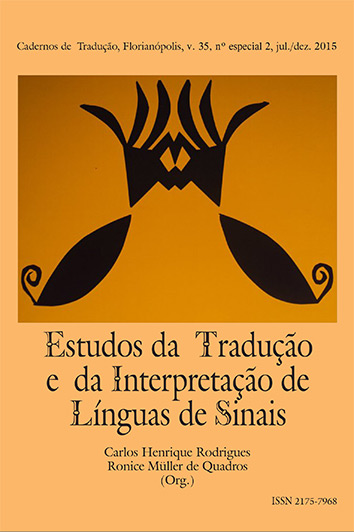Testando a hipótese da “corda bamba” do modelo dos esforços na interpretação simultânea – uma contribuição
DOI:
https://doi.org/10.5007/2175-7968.2015v35nesp2p590Resumo
Em uma amostra de 10 intérpretes profissionais interpretando no modo simultâneo um mesmo discurso foram identificados erros e omissões que afetam diferentes segmentos da língua fonte e uma grande parte deles apenas ocorreu na interpretação de uma pequena parte dos sujeitos. Na segunda vez que realizaram a interpretação ocorreram novos erros e omissões nos trechos que anteriormente tinham interpretado corretamente. Estes resultados corroboram com a “Hipótese da Corda Bamba” do Modelo dos Esforços, pois os erros e as omissões não são causados pela dificuldade intrínseca dos respectivos segmentos na língua fonte, mas devidos ao fato de que os intérpretes estão trabalhando muito próximo ao nível de saturação de sua capacidade de processamento, o que os torna vulneráveis a variações na capacidade de processamento disponível para interpretação de cada trecho, mesmo que pequenas.
Referências
Cattaneo, E. 2004. Idiomatic expressions in conference interpreting. Graduation thesis, SSLMIT, Università degli Studi di Bologna, Sede di Forlì.
Chincotta, Dino & Geoffrey Underwood. 1998. “Simultaneous Interpreters and the effect of concurrent articulation on immediate memory”. Interpreting 3:1. 1-20.
Daró, Valeria & Franco Faabro. 1994. “Verbal memory during simultaneous interpretation. Effects of phonological interference.” Applied Linguistics 15.365-381.
Dawrant, Andrew. 1996. Word Order in Chinese-English Simultaneous Interpretation.
An Initial Exploration. Unpublished MA thesis, Fu Jen University.
Gerver, David. 1976. “Empirical studies of simultaneous interpretation: a review and a model.” In R.W. Brislin (ed). Translation: Applications and Research. New York: Gardner. 165-207.
Frauenfelder, Uli & Herbert Schriefers. 1997. “A psycholinguistic perspective on Simultaneous Interpretation.” Interpreting 2:1-2. 55-89.
Fukuii, Haruhiro & Tasuke Asano. 1961. Eigotsuuyaku no jissai. An English Interpreter’s Manual. Tokyo: Kenkyusha.
Gile, Daniel. 1984. « Les noms propres en interprétation simultanée ». Multilingua 3 :2. 79-85.
Gile, Daniel. 1989. La communication linguistique en réunion multilingue. Les difficultés de la transmission informationnelle en interprétation simultanée. Unpublished doctoral dissertation, Université Paris 3.
Gile, Daniel. 1991. « Prise de notes et attention en début d’apprentissage de l’interprétation consécutive - une expérience-démonstration de sensibilisation ». Meta 36 :2-3. 431-439.
Gile, Daniel. 1992. “Predictable Sentence Endings in Japanese and Conference Interpretation.” The Interpreters’ Newsletter, Special Issue n°1. 12-23.
Gile, Daniel. 1995. Basic Concepts and Models for Interpreter and Translator Training. Amsterdam/Philadelphia: John Benjamins.
Gile, Daniel. 1997. “Conference Interpreting as a Cognitive Management Problem.” In Danks, Joseph E., Gregory M Shreve, Stephen B. Fountain, Michael K. McBeath (eds). Cognitive Processes in Translation and Interpreting. Thousand Oaks, London and New York: Sage Publications. 196-214.
Gile, Daniel. 1999. “Variability in the perception of fidelity in simultaneous interpretation.” Hermes 22. 51-80.
Gran, Laura & Beatrice Bellini. 1996. “Short-Term memory and Simultaneous Interpretation: An Experimental Study on Verbatim Recall.” The Interpreters’ Newsletter 7. 103-112.
Granacher, Martin. 1996. Das Modèle d’Efforts des Simultandolmetschens von Daniel Gile. Versuch einer Evaluierung auf der Grundlage einer Fallstudie. Diplomarbeit, Universtität Heidelberg.
Kade, Otto & Claus Cartellieri. 1971. “Some methodological aspects of simultaneous interpreting.” Babel 17:2. 12-16.
Lamberger-Felber, Heike. 1998. Der Einfluss kontextueller Faktoren auf das Simultandolmetschen. Eine Fallstudie am Beispiel gelesener Reden. Unpublished doctoral dissertation, Karl-Franzens-Universität Graz.
Lambert, Sylvie. 1995. “Foreword.” In Lambert, Sylvie & Barbara Moser-Mercer (eds). Bridging the Gap. Empirical research in simultaneous interpretation. Amsterdam/Philadelphia: John Benjamins. 5-14.
Massaro, Dominic W. & Miriam Shlesinger. 1997. “Information processing and a computational approach to the study of simultaneous interpretation.” Interpreting 2:1-2. 13-53.
Mazza, C. 2000. Numbers in Simultaneous Interpretation. Graduation thesis, SSLMIT, Università degli Studi di Bologna, Sede di Forlì.
Mizuno, Akira. 1994. “The Dynamic Model of Simultaneous Interpretation (I).” Interpreting Research 7(IV/2). 13-25. (in Japanese).
Mizuno, Akira. 1995. “The Dynamic Model of Simultaneous Interpretation (II): A Pilot Study on the Convergence of Translation Patterns.” Interpreting Research 8(V/1). 9-26. (in Japanese).
Moser, Barbara. 1978. “Simultaneous Interpretation: a Hypothetical Model and its Practical Application.” In Gerver, David D. & H. Wallace Sinaiko (eds). Language Interpretation and Communication. NATO Conference Series, Series III: Human Factors. New York and London: Plenum Press. 353-368.
Moser-Mercer, Barbara. 1997. “Methodological issues in interpreting research: An introduction to the Ascona workshops.” Interpreting 2:1-2. 1-11.
Oléron, P. & H. Nanpon. 1965. « Recherches sur la traduction simultanée ». Journal de psychologie normale et pathologique 62. 73-94.
Osaka, Mariko. 1994. “Riidingu supan no kenkyuu (5) – Doujitsuuyaku tesuto to waakingu memory” (Simultaneous interpreting tests and working memory). Nihon shinri gakkai dai 58 kai taikai ronbunshuu (Proceedings of the 58th Convention of the Japan Psychological Society). 710.
Padilla, Presentación. 1995. Procesos de memoria y atención en la interpretación de lenguas. Tesis doctoral, Universidad de Granada, Departamento de Filología Inglesa.
Puková, Z. 2006. Daniel Gile’s Effort Model and its application to simultaneous interpreting of texts with a high concentration of numerical data and enumerations (in Czech). Master’s thesis, Charles University, Prague.
Paradis, Michel. 1994. “Toward a neurolinguistic theory of simultaneous translation. The framework.” International Journal of Psycholinguistics 10:3. 319-335.
Sabatini, Elisabetta. 1998. Comprehension difficulties in simultaneous interpretation from “non standard” English. Graduation thesis, SSLMIT, Università degli Studi di Bologna, Sede di Forlì.
Schjoldager, Anne. 1996. Simultaneous Interpreting: Empirical Investigation into Target-text Source-text Relations. Unpublished PhD dissertation, Aarhus School of Business, Faculty of Modern Languages.
Setton, Robin. 1997. A Pragmatic Theory of Simultaneous Interpretation. Unpublished doctoral dissertation, The Chinese University of Hong Kong, Graduate Division of English/Applied Linguistics.
Downloads
Publicado
Como Citar
Edição
Seção
Licença
Autores têm autorização para assumir contratos adicionais separadamente, para distribuição não exclusiva da versão do trabalho publicada nesta revista (ex.: publicar em repositório institucional ou como capítulo de livro, com reconhecimento de autoria e publicação inicial nesta revista).





















































